Welcome to Rayong, Thailand, an area known for its diverse bird population. This region is home to more than 380 species of birds, making it an excellent place for birdwatching.
Rayong offers something for everyone, from the colorful sunbirds and bulbuls to the rare and endangered species of birds. Whether you’re a beginner or an experienced birdwatcher, there are plenty of opportunities to observe and appreciate the birds of Rayong.
From the mangrove forests to the highlands, you can explore and discover the fantastic variety of birds that make this region unique.
22 Birds Found in Rayong
If you are a bird lover, you might want to visit Rayong, Thailand, an area known for its diverse bird population. This region is home to more than 380 species of birds, making it an excellent place for birdwatching.
From the colorful sunbirds and bulbuls, to the rare and endangered species of birds, Rayong offers something for everyone.
Here are 22 birds that you can find in Rayong.
1. Red-Wattled Lapwing
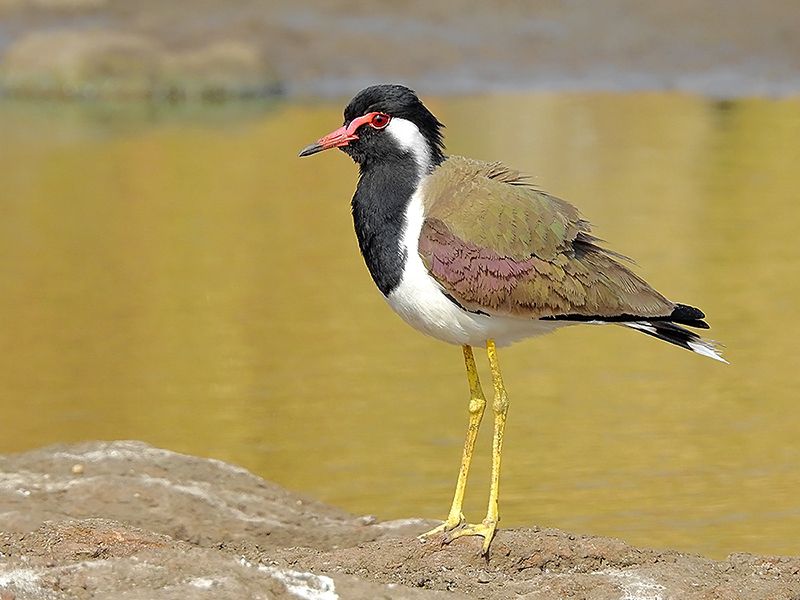
The red-wattled lapwing is a species of bird that belongs to the family Charadriidae, which includes lapwings and large plovers. It is native to Asia and is found on the ground since it cannot perch on trees or other high points.
The red-wattled lapwing is a wader, meaning it spends much of its time in and around wetlands, rivers, and other areas with shallow water and mud.
These birds have a distinctive red wattle on their heads that is used to help them identify each other in the wild. The red-wattled lapwing is omnivorous, and its diet consists of small insects, mollusks, worms, and other invertebrates.
It also eats some plant material, such as seeds and fruits. These birds are usually found in small flocks and can often be seen foraging on the ground together in search of food.
They are also known to nest on the ground and may use an existing depression or scrape out a shallow depression in the soil. The red-wattled lapwing is a vocal species, and they are known for their loud calls.
The call of the red-wattled lapwing is a far-carrying ‘pee-wit,’ and they will often give this call when alarmed or defending their territory. Overall, the red-wattled lapwing is an important species of bird that plays a vital role in its ecosystem.
| Kingdom | Animalia |
| Phylum | Chordata |
| Class | Aves |
| Order | Charadriiformes |
| Family | Charadriidae |
| Genus | Vanellus |
| Species | V. indicus |
2. Lesser Whistling Duck
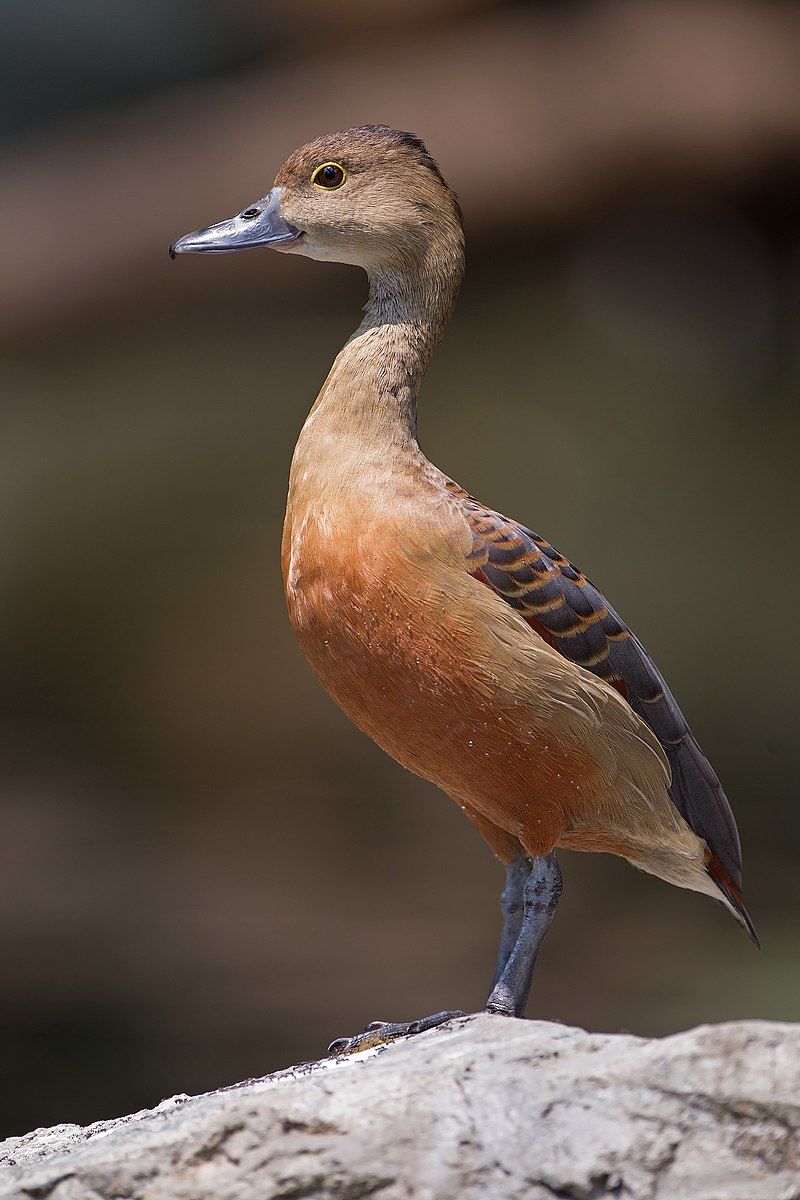
The lesser whistling duck is found in the Indian subcontinent and Southeast Asia. It is also known as the Indian whistling duck or lesser whistling teal.
These ducks are nocturnal feeders, meaning they spend the night seeking food and returning to their original location during the day. During the day, these ducks may be seen in flocks around lakes and wet paddy fields.
They are usually found in these wet habitats because they need access to plenty of water for drinking and bathing. The lesser whistling duck is a relatively small species, usually weighing between 400 and 700 grams.
They use a distinctive whistling call to communicate with each other. This duck species is also known for its social behavior, often forming large flocks of hundreds of individuals.
They are omnivorous, feeding various aquatic plants, insects, and small fish. Because of their social behavior and adaptable diet, they can often be seen in large numbers in wetland areas.
| Kingdom | Animalia |
| Phylum | Chordata |
| Class | Aves |
| Order | Anseriformes |
| Family | Anatidae |
| Genus | Dendrocygna |
| Species | D. javanica |
3. Zebra Dove
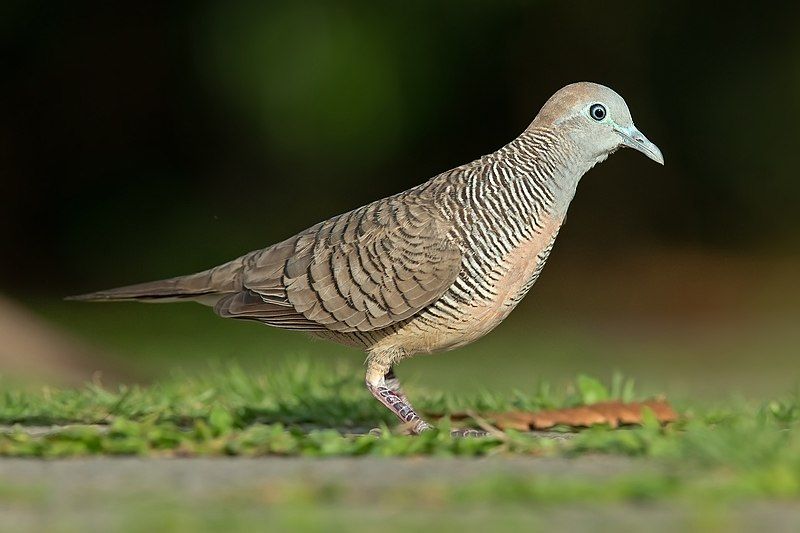
The Zebra Dove is a small species of bird that belongs to the Dove family, Columbidae. It is native to Southeast Asia and is easily recognizable by its distinct coloring. Its feathers are primarily brownish-grey in shade and feature black-and-white barring all over its body.
The Zebra Dove has a long tail that adds to its unique look. It is also known as the Barred Ground Dove or Barred Dove due to the barring on its feathers. These birds are usually found in tropical and subtropical forests, mangroves, shrublands, and grasslands.
They are monogamous and can be found in pairs or small family groups, though they are also sometimes seen alone. They are known for their mellow and pleasant call, often heard in the mornings and evenings.
They feed primarily on insects and fruit and can be seen in gardens and parks. Overall, the Zebra Dove is a fascinating species of bird that can easily be found in Southeast Asia. Its characteristic coloring and call make it an attractive species to observe and appreciate.
| Kingdom | Animalia |
| Phylum | Chordata |
| Class | Aves |
| Order | Columbiformes |
| Family | Columbidae |
| Genus | Geopelia |
| Species | G. striata |
4. Spotted Dove
The spotted dove is a small pigeon species native to the Indian subcontinent and Southeast Asia. It is a reasonably long-tailed bird and is a common resident breeding bird in its native range.
Over the years, the spotted dove has been introduced to many other parts of the world and has successfully established feral populations in these areas.
The adaptability of this species has allowed it to thrive in different climates and environments, making it a successful inhabitant in many other countries.
| Kingdom | Animalia |
| Phylum | Chordata |
| Class | Aves |
| Order | Columbiformes |
| Family | Columbidae |
| Genus | Spilopelia |
| Species | S. chinensis |
5. Pink-Necked Green Pigeon
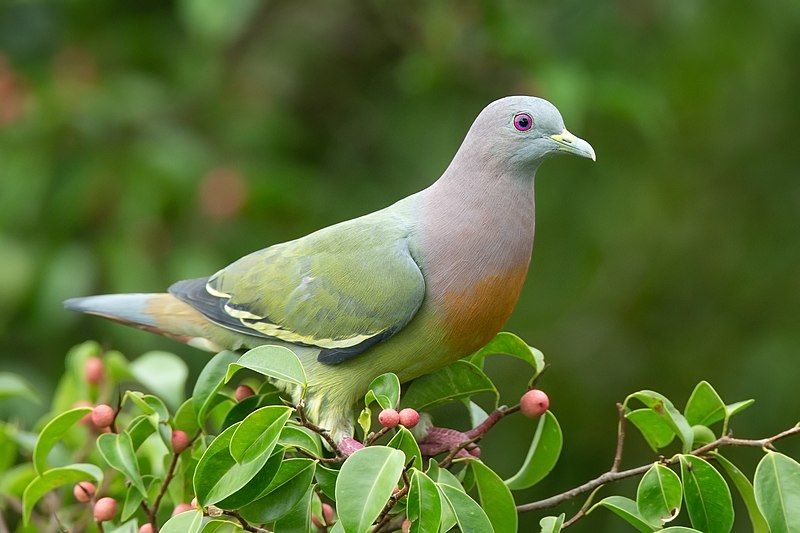
The pink-necked green pigeon is a beautiful species of bird. It is a member of the Columbidae family, which includes both pigeons and doves.
This bird species is native to Southeast Asia, and its range extends from Myanmar and Vietnam south to the major islands of Indonesia and the Philippines. It is a common species in these areas, often seen in fields, gardens, and woodlands.
The pink-necked green pigeon has a beautiful green body, wings, and a pale pink neck and breast. Its head is grayish brown, with darker wingtips, and it has a black bill and red eyes.
The pink-necked green pigeon is usually seen in pairs or small groups and feeds mainly on seeds, fruit, and small insects. It is an essential species for local agriculture, as it helps to disperse seeds and pollinate crops.
This species was first described in 1854 and is still widely seen throughout its range.
| Kingdom | Animalia |
| Phylum | Chordata |
| Class | Aves |
| Order | Columbiformes |
| Family | Columbidae |
| Genus | Treron |
| Species | T. vernans |
6. Indian Spot-Billed Duck
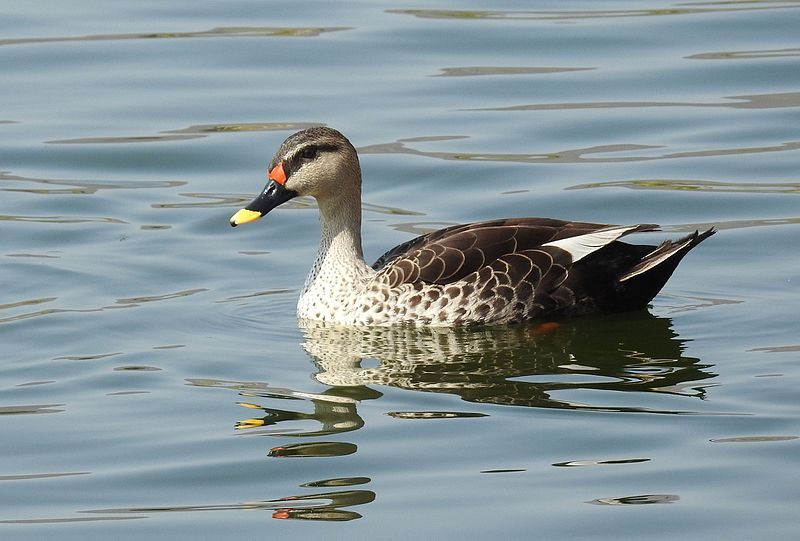
The Indian spot-billed duck is a species of dabbling duck found in the Indian subcontinent. It is a large duck, typically measuring between 50 and 60 cm in length.
It is a non-migratory species, meaning it does not migrate seasonally but breeds and stays in freshwater wetlands throughout the year.
The name of this species is derived from the distinctive red spot at the base of its bill, which is found in the mainland Indian population. This species is a famous game bird hunted by local hunters for its meat.
It is also a famous bird in captivity due to its attractive plumage and tameness towards humans.
| Kingdom | Animalia |
| Phylum | Chordata |
| Class | Aves |
| Order | Anseriformes |
| Family | Anatidae |
| Genus | Anas |
| Species | A. poecilorhyncha |
7. Thick-Billed Green Pigeon
The thick-billed green pigeon is a beautiful species of bird. It is a member of the Columbidae family, which is also known as the pigeon family.
This bird species is found throughout South and Southeast Asia and is known for its bright green plumage and distinctively thick bill. The thick bill is used to help the pigeon feed on fruits and nuts, such as hard-shelled fruits like jackfruit.
The colorful green plumage serves as camouflage from potential predators in the dense forests and jungles where they reside. Thick-billed green pigeons live in small flocks and usually roost in trees.
They are known to be friendly and most active during the day, often seen resting in the trees or ground. During mating season, they form monogamous pairs and nest in the tree canopy.
The female usually lays two eggs, and the parents take turns incubating them. These birds have unique songs; some even keep them as pets. They are a protected species in some countries, and their population slowly increases due to conservation efforts.
The thick-billed green pigeon is an integral part of the ecosystems in its range, and it’s essential to protect their habitats and ensure they can thrive in the wild.
| Kingdom | Animalia |
| Phylum | Chordata |
| Class | Aves |
| Order | Columbiformes |
| Family | Columbidae |
| Genus | Treron |
| Species | T. curvirostra |
8. Indian Cuckoo
The Indian cuckoo is a distinctive species of bird found primarily in the Indian subcontinent and Southeast Asia. It is part of the Cuculiformes order, which includes other cuckoo species, such as the Common Cuckoo and the European Cuckoo.
The Indian cuckoo can be found in various countries, including India, Bangladesh, Bhutan, Nepal, Sri Lanka, Indonesia, China, and Russia. This broad range covers multiple climates, allowing the Indian cuckoo to adapt to various habitats.
The Indian cuckoo is a solitary bird known for its distinctive call. It is most active during the day and will feed on various insects and fruits. It is a migratory bird and will move to different parts of its range depending on the season.
During the colder months, the Indian cuckoo can be found in parts of South Asia and Southeast Asia, while during the warmer months, it can be seen in parts of Central Asia.
The Indian cuckoo is an important species to various ecosystems and is vital in the food chain. Its presence is an indicator of healthy habitats and a valuable food source for other species.
Unfortunately, the Indian cuckoo is threatened by habitat loss and illegal hunting. Conservation efforts are needed to protect this unique species and ensure its survival.
| Kingdom | Animalia |
| Phylum | Chordata |
| Class | Aves |
| Order | Cuculiformes |
| Family | Cuculidae |
| Genus | Cuculus |
| Species | C. micropterus |
9. Square-Tailed Drongo-Cuckoo
The square-tailed drongo-cuckoo, a species of cuckoo, is easily identifiable by its similarity to a black drongo. It was previously classified under S. lugubrious, with a subspecies known as the dichlorides.
However, this subspecies is now considered a separate species, called the fork-tailed drongo-cuckoo. This species has a distinct tail shape, with two separate feathers making up the tail, rather than the single feather of the square-tailed drongo-cuckoo.
The fork-tailed drongo-cuckoo is slightly larger than its square-tailed counterpart and has a more pointed beak. Both species are found in the tropical regions of Africa, India, and Southeast Asia.
While the square-tailed drongo-cuckoo is an insect-eating bird, the fork-tailed drongo-cuckoo is more omnivorous, eating various insects, fruits, and even other small birds.
| Kingdom | Animalia |
| Phylum | Chordata |
| Class | Aves |
| Order | Cuculiformes |
| Family | Cuculidae |
| Genus | Surniculus |
| Species | S. lugubris |
10. Red-Collared Dove
The red-collared dove is a small pigeon species found in the tropical regions of Asia. It is known for its distinctive red-brown body and blue-grey head in the males.
The female red-collared dove is much plain, with pale brown plumage similar to the more giant Eurasian-collared dove. This species is a resident breeding bird, meaning it stays in the same area year-round and builds nests to raise their young.
Red-collared doves are usually found in small flocks and have various vocalizations. They feed mainly on seeds and grains and are known to be exceptionally social and friendly birds.
These doves are a famous sight in many tropical regions of Asia and are commonly kept as pets owing to their attractive colors and friendly nature.
| Kingdom | Animalia |
| Phylum | Chordata |
| Class | Aves |
| Order | Columbiformes |
| Family | Columbidae |
| Genus | Streptopelia |
| Species | S. tranquebarica |
11. Garganey
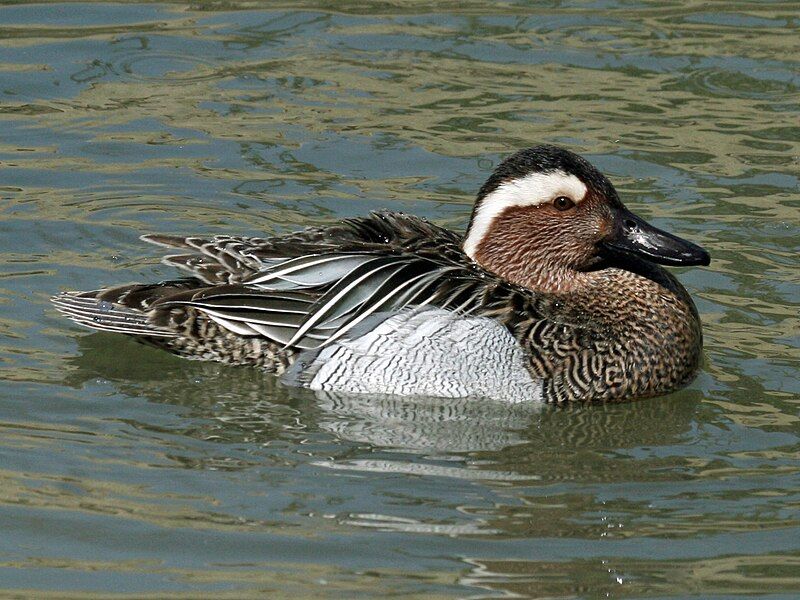
The Garganey is a species of small dabbling duck found in much of Europe and the Palearctic. It is known for its migratory behavior, with the whole population moving to warmer climates during the winter months in the Northern Hemisphere.
These wintering grounds can be found in southern Africa, India, Bangladesh, and Australasia, where large flocks of different species can be seen. The Garganey is a relatively small duck with a body length of around 14 inches.
It has a brown-grey body and head, a white eye ring, and white-tipped wings. The male has a chestnut-colored forehead and a blue-green patch on its head, while the female has a uniform grey color.
The Garganey also has a distinctive white spot on its back, unique to the species. The Garganey breeds in wetlands, marshes, and other shallow water habitats. It feeds on aquatic insects, crustaceans, and plant material, dabbling in the water to forage.
During the breeding season, the male will perform a courtship display involving an up-and-down wing-flapping motion. In the winter, the Garganey will migrate to warmer climates.
This is an essential strategy for the species, as it helps it survive in harsher climates. Large species flocks can be seen in the wintering grounds of southern Africa, India, Bangladesh, and Australasia.
This large-scale migration makes the Garganey a fascinating species to observe.
| Kingdom | Animalia |
| Phylum | Chordata |
| Class | Aves |
| Order | Anseriformes |
| Family | Anatidae |
| Genus | Spatula |
| Species | S. querquedula |
12. Collared Kingfisher
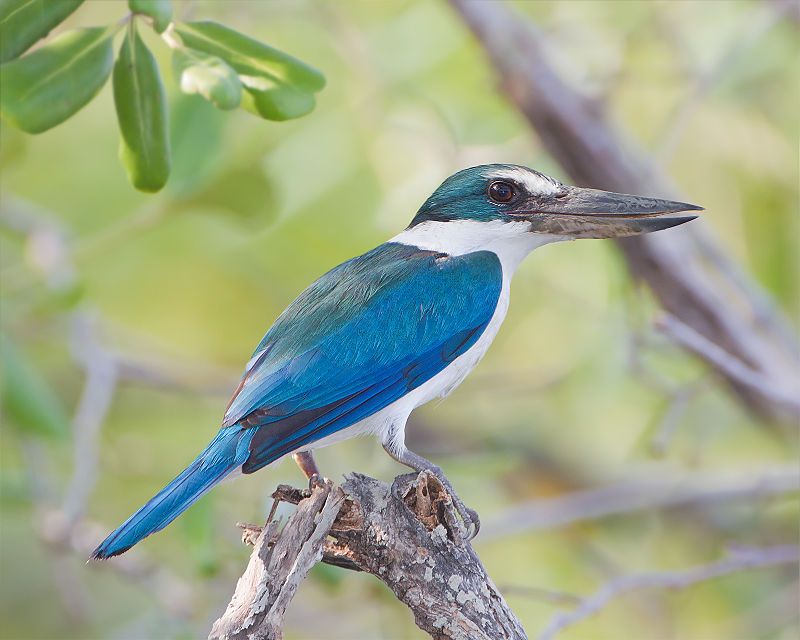
The collared kingfisher is a type of kingfisher belonging to the subfamily Halcyoninae, also known as the tree kingfisher. It is a medium-sized bird often called the white-collared kingfisher, black-masked kingfisher, or mangrove kingfisher.
The collared kingfisher has an extensive range, extending from the Red Sea across southern Asia to Polynesia. This makes it one of the most widely distributed of the kingfishers.
It can be found in many places, including mangrove forests, estuaries, and other coastal habitats. The collared kingfisher can also be found in inland areas, such as flooded plains and mountain areas.
The collared kingfisher is a very adaptable bird, making it possible to survive in various habitats. It is a beautiful bird, with its bright blue and white plumage and distinctive black mask.
Its diet consists mainly of small fish and crabs, which it hunts from a low perch. The collared kingfisher is an excellent example of a species that has survived and thrived in various habitats, making it a fascinating species to observe.
| Kingdom | Animalia |
| Phylum | Chordata |
| Class | Aves |
| Order | Coraciiformes |
| Family | Alcedinidae |
| Genus | Todiramphus |
| Species | T. chloris |
13. Green Imperial Pigeon
The green imperial pigeon is a large forest pigeon found in many regions. It is native to Nepal, southern India, and Sri Lanka and extends eastwards to south China, Indonesia, and the Philippines.
This pigeon species has predominantly green plumage, white on its wings’ tips, and a red iris. It is a large bird, measuring up to 15 inches in length, with a wingspan of up to two feet.
Its diet consists mainly of fruits and nuts, such as wild figs, and it can also be found in bamboo and deciduous forests. The green imperial pigeon is considered a vulnerable species, as its population has declined due to deforestation and habitat destruction.
It is also hunted for its meat and eggs, a significant threat to its survival. Conservation efforts are being made to protect the species, and it is listed on the IUCN Red List as Near Threatened.
| Kingdom | Animalia |
| Phylum | Chordata |
| Class | Aves |
| Order | Columbiformes |
| Family | Columbidae |
| Genus | Ducula |
| Species | D. aenea |
14. Blue-Winged Pitta
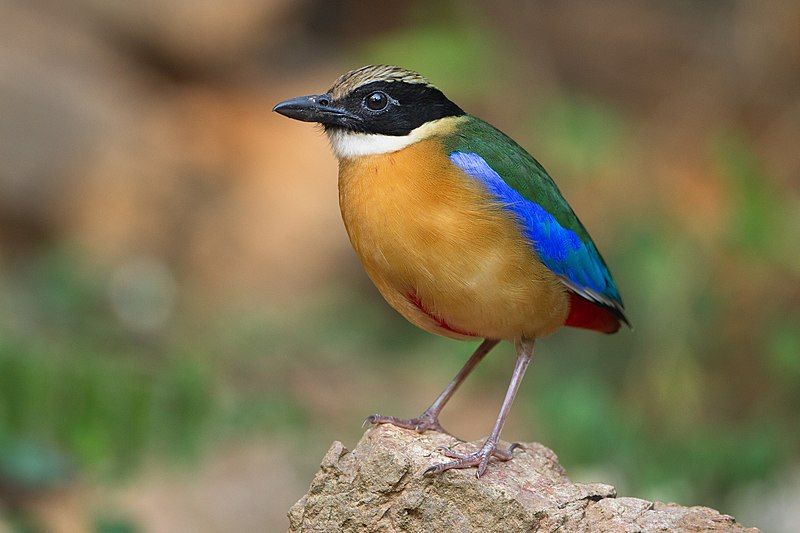
The blue-winged pitta is a Pittidae family member, including passerine birds. It is part of a larger group of four types of pittas, which are related species. These four types are the blue-winged pitta, the Indian pitta, the fairy pitta, and the mangrove pitta.
These species are known as superspecies, meaning they are closely related and have many shared characteristics. The blue-winged pitta is found in Southeast Asia, including Myanmar, Thailand, Laos, and Vietnam.
It has a distinctive deep blue head and wings, and its body is mainly brown. It feeds primarily on insects but eats small fruits and berries. Its habitat is usually lowland forests and wetlands, where it builds its nest in tree crevices or other sheltered areas.
The Indian pitta is found in India, Sri Lanka, Bangladesh, and Nepal. It is mainly green, with a yellow breast and black wings. The fairy pitta is found in Japan, Korea, and eastern Russia, and it is similar in color to the Indian pitta but with a white throat.
The mangrove pitta in Southeast Asia is mainly black, with a bright orange breast. The four types of pittas in the superspecies have many similarities, including their small size, colorful plumage, and insect-eating habits.
They also share similar habitats and nesting sites. The close evolutionary relationship between these species is an exciting example of how related species can be found in different parts of the world.
| Kingdom | Animalia |
| Phylum | Chordata |
| Class | Aves |
| Order | Passeriformes |
| Family | Pittidae |
| Genus | Pitta |
| Species | P. moluccensis |
15. Great-Eared Nightjar
The great-eared nightjar is a species of nightjar belonging to the family Caprimulgidae. This species is native to southwest India and Southeast Asia and can be found in various habitats.
The great-eared nightjar is very large, with long barred wings and a barred tail. It is easily identified by its long ear tufts, which are often recumbent. These ear tufts are unique among nightjars, making this species easy to distinguish from other similar birds.
The great-eared nightjar also has a distinctive call, consisting of a rapid series of ‘churring’ sounds. This species is primarily active around dusk and dawn when it can be seen flying in pursuit of insects.
The great-eared nightjar is an integral part of the ecosystem, as it helps to control insect populations. It is also a popular target for birdwatchers, as it is relatively easy to spot due to its size and distinctive markings.
| Kingdom | Animalia |
| Phylum | Chordata |
| Class | Aves |
| Clade | Strisores |
| Order | Caprimulgiformes |
| Family | Caprimulgidae |
| Genus | Lyncornis |
| Species | L. macrotis |
16. Blue-Breasted Quail
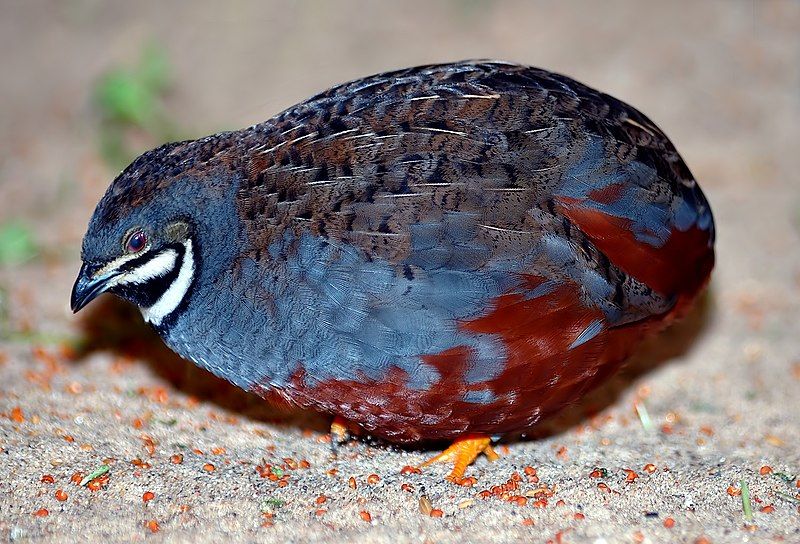
The king quail, scientifically known as Coturnix chinensis, is a species of quail in the family Phasianidae.
It is native to eastern and southern Asia, ranging from China to India, and is known by various common names such as the blue-breasted quail, Asian blue quail, Chinese painted quail, or Chung-Chi.
The king quail is a small bird, typically measuring up to 10 cm in length, with a body weight of up to 60 grams.
They are characterized by a brownish-grey back and wings, a white chest, and a bright blue patch on their head and breast. The king quail is a ground-dwelling bird, typically found in open grasslands or cultivated areas.
They feed on various seeds and insects and are highly social. They form small flocks and communicate with multiple short, sharp calls. The king quail is also a famous game bird and is hunted for sport in many parts of its range.
The species is relatively common in its range and is not currently considered threatened.
| Kingdom | Animalia |
| Phylum | Chordata |
| Class | Aves |
| Order | Galliformes |
| Family | Phasianidae |
| Genus | Synoicus |
| Species | S. chinensis |
17. Green-Legged Partridge
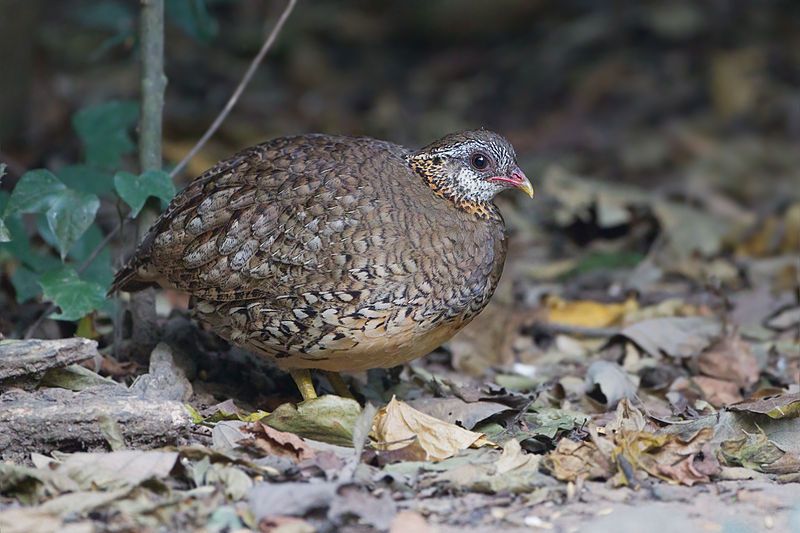
The green-legged partridge, also known as the scaly-breasted partridge or green-legged hill-partridge, is a bird species belonging to the Phasianidae family, which includes pheasants, grouse, and quail.
This species is native to Indochina, a geographic region covering parts of Cambodia, Laos, Vietnam, and southern China’s Yunnan and Guangxi provinces.
This species, also known as the Vietnam partridge, is sometimes considered a subspecies of the green-legged partridge due to their similar characteristics. The green-legged partridge is a small bird with a body length of around 30 cm and a weight of around 250-300 g.
It has a plump body, a short tail, and a pale brown head with dark stripes. The body is primarily gray with a white chest, belly, and olive-green legs.
The male has a blackish throat, while the female has a brownish throat. In the wild, the green-legged partridge can be found in evergreen and bamboo forests and in scrubland. It feeds on seeds, berries, and insects, which it finds among the leaf litter.
The green-legged partridge is monogamous, and the breeding season usually occurs during summer. The female lays 3-5 eggs in a cup-shaped nest, traditionally built among rocks or in a tree.
| Kingdom | Animalia |
| Phylum | Chordata |
| Class | Aves |
| Order | Galliformes |
| Family | Phasianidae |
| Genus | Tropicoperdix |
| Species | T. chloropus |
18. Orange-breasted green Pigeon
The orange-breasted green pigeon is found in tropical climates across the Indian Subcontinent and Southeast Asia. These birds have orange-colored breasts and are mainly green, thus giving them their common name.
The green pigeon feeds primarily on small fruits and can be found in pairs or small flocks.
They move slowly and quietly while searching for food on trees, making them difficult to spot and observe. The orange-breasted green pigeons are usually shy and prefer to avoid human activity.
They may be found in various habitats, such as forests, woodlands, and urban gardens. They are often seen in large flocks and can be heard making loud and distinctive calls.
It is believed that these birds are monogamous, forming pairs for life. This pigeon species is vital to tropical ecosystems, as it helps disperse the seeds of fruits it eats.
This allows for the growth of new plants and helps maintain the environment’s balance. The orange-breasted green pigeon is also a famous bird among birdwatchers and photographers, as it is both beautiful and rare.
It is essential to protect this species, as its numbers are decreasing due to habitat destruction.
| Kingdom | Animalia |
| Phylum | Chordata |
| Class | Aves |
| Order | Columbiformes |
| Family | Columbidae |
| Genus | Treron |
| Species | T. bicinctus |
19. Silver Pheasant
The silver pheasant is a species native to mainland Southeast Asia and parts of eastern and southern China. This beautiful bird is known for its striking coloration, with males having a black-and-white pattern while the females are mainly brown.
It is usually found in forests, mainly mountainous areas, but there is an introduced population of silver pheasants on Victoria Island in Nahuel Huapi Lake, Neuquén, Argentina.
Silver pheasants have been hunted for their feathers since ancient times, and their populations have declined significantly due to hunting and habitat loss.
The International Union for Conservation of Nature (IUCN) lists the silver pheasant as Near Threatened, meaning it is at risk of becoming endangered shortly.
Conservation efforts are needed to protect this species and its habitat so that it can continue to thrive.
| Kingdom | Animalia |
| Phylum | Chordata |
| Class | Aves |
| Order | Galliformes |
| Family | Phasianidae |
| Genus | Lophura |
| Species | L. nycthemera |
20. Pied Imperial Pigeon
The Pied Imperial Pigeon is a species of pigeon known for its distinctive black-and-white plumage.
It is a relatively large species found primarily in Southeast Asia, ranging from Myanmar and Thailand throughout Indonesia and east to the Philippines and even the Bird’s Head Peninsula of New Guinea.
This bird inhabits various habitats, including forests, woodlands, mangroves, plantations, and scrub. It is a highly adaptable bird and can be seen in urban parks and other areas of human habitation.
Although not considered threatened, the Pied Imperial Pigeon is still vulnerable to human disturbance and exploitation of its habitat. Conservation efforts are needed to ensure the long-term survival of this beautiful species.
| Kingdom | Animalia |
| Phylum | Chordata |
| Class | Aves |
| Order | Columbiformes |
| Family | Columbidae |
| Genus | Ducula |
| Species | D. bicolor |
21. Mountain Imperial Pigeon
The mountain imperial pigeon is an interesting species of bird that belongs to the pigeon and dove family. It is native to southeastern Asia and has a wide range. It is also known as the maroon-backed imperial pigeon and Hodgson’s imperial pigeon.
This bird is quite remarkable in its size; it has a length of 40 to 43 centimeters and a wingspan of up to 75 centimeters. The plumage is characterized by a white head, neck, and upper breast, while the lower breast and belly are grayish-blue.
The back and wings are maroon-colored, and the tail is blackish. The mountain imperial pigeon is a social species, forming flocks when not breeding. It mainly feeds on fruits, nuts, and berries, which it finds on the ground or in trees.
It builds its nest in large trees, often near water sources. Its call is a loud, two-syllable cooing sound. The population of the mountain imperial pigeon is decreasing due to deforestation and hunting. It is listed as Near Threatened on the IUCN Red List.
Conservation efforts are underway to protect this species and its habitat.
| Kingdom | Animalia |
| Phylum | Chordata |
| Class | Aves |
| Order | Columbiformes |
| Family | Columbidae |
| Genus | Ducula |
| Species | D. badia |
22. Siamese Fireback
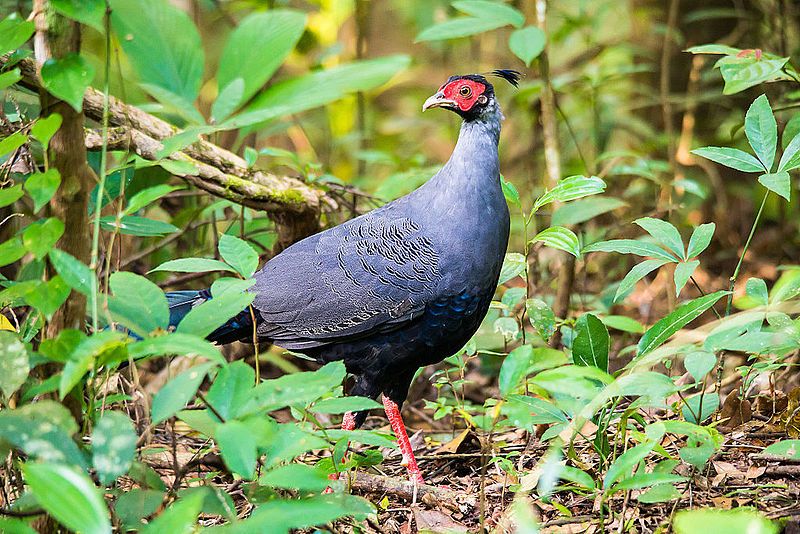
The Siamese Fireback, also known as Diard’s Fireback, is a pheasant native to Southeast Asia. It is a relatively large bird, measuring approximately 80 centimeters in length.
The male of the species is easily identifiable due to its distinct plumage, which is grey and features an extensive facial caruncle. Its legs and feet are a deep crimson, while its ornamental crest feathers, iris, and tail are all blackish-brown.
The tail itself is long and curved, adding to its distinct appearance. The Siamese Fireback is an impressive sight in the wild, providing a splash of color to the landscape.
| Kingdom | Animalia |
| Phylum | Chordata |
| Class | Aves |
| Order | Galliformes |
| Family | Phasianidae |
| Genus | Lophura |
| Species | L. diardi |
Conclusion
Birds play an essential role in the Rayong ecosystem. They help maintain the balance of nature by eating insects and other pests, dispersing seeds, and providing food for different animals.
The diversity of bird species in Rayong is also essential to the region’s rich natural heritage, making it a great place for birdwatchers.
Therefore, it is essential to take steps to preserve the habitat of these birds and ensure that they remain a part of the balance of the Rayong ecosystem for generations to come.